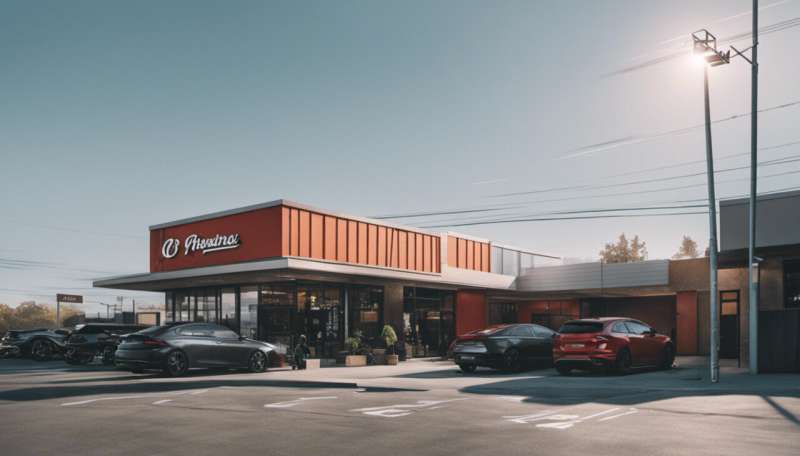This article has been reviewed according to Science X's editorial process and policies. Editors have highlighted the following attributes while ensuring the content's credibility:
fact-checked
trusted source
written by researcher(s)
proofread
Shops and restaurants can help blur class lines, but interactions may not be meaningful enough to boost social mobility

"Titanic," James Cameron's 1997 multi-Oscar-winning movie, focused on the tragic love story of itinerant artist Jack and upper-class socialite Rose. Among their other on-board adventures, they dined in the first-class section of the ship before joining revelers dancing in the third-class quarters. Their exploration of the ill-fated vessel represents a transgression—not just of public boundaries, but of class ones too.
More recently, mobile phone location data is being used to track such interactions across class boundaries. Understanding class segregation matters because, as economists like Raj Chetty point out, interaction or "economic connectedness" between low and high-income groups is a key predictor of how likely people are to be able to move up the social ladder.
This is crucial at a time when, in the UK, social mobility is at a low. People now find it much harder to out-earn their parents, according to think tank Institute for Fiscal Studies.
Had the Titanic's passengers had access to mobile phones in 1912, the data generated by examining the proximity—and therefore potential interaction—of passengers would have given the impression the Titanic was a sort of utopia for social interaction.
People from diverse social and ethnic backgrounds were seemingly thrown together on board—from the poorest European migrants seeking better lives in the "New World," to the wealthiest of Edwardian socialites, shuttling from the salons of London and Paris to New York and Philadelphia. Of course, accommodation on board was highly segregated, as shown in the movie, but the whole spectrum of the Edwardian era was represented on the one ship.
But, as with today's data, the reality was very different. Nothing shows the entrenched social gradient that traveled with the Titanic's passengers more than the statistics on deaths after the ship sank: just a quarter of third-class passengers survived compared to 62% of those in first class.
The experience of the Titanic's passengers points to the challenges and opportunities that still exist today when trying to understand social interaction and mobility.
Big data doesn't reveal real interactions
When studying class interactions, demographers and statisticians have traditionally been largely limited to static and infrequently updated tools such as a census every ten years. But residence is a blunt instrument when trying to understand class segregation. Domicile has always been just one aspect of the lived reality of segregation—even if it might be the defining feature. In the most segregated of spaces, most people spend their daily lives elsewhere: studying, shopping, working or pursuing leisure activities.
Recent US research illustrates the potential for teasing out some of this complexity using "big" data about people's locations and movements. Because so many of us own smartphones, researchers can track people as they work, rest and play. This can offer rich new insights into how people from different class backgrounds interact across the course of the day.
The US analysis leads the study's authors to some important insights, most notably that it is the wealthiest, not the poorest, fraction of society that is, statistically speaking, most socially "isolated."
This echoes the work of urban geographers and sociologists on this side of the Atlantic. They have identified groups of the very richest in society who have adopted strategies of "limited exposure". For example, people might use tactics such as "verticality"—using high-rise penthouses or subterranean "billionaire bunkers") to evade the gaze of the masses.
Perhaps more controversially, the recent US paper also concludes: "places that contribute most to mixing by economic class are not civic spaces like churches or schools, but large, affordable chain restaurants and stores." The researchers specifically mention US eateries Olive Garden and Applebee's. Policymakers should therefore "pay attention to the role of firms in shaping class mixing."
While revealing in many ways, this kind of data can tell us nothing about how meaningful these "interactions" in the market actually are. The people captured in such studies may have simply shared the same commercial spaces for an hour or less, without even speaking.
A 'new snobbery'
We also have to consider the idea of "knowingness" in consumption patterns. This is something I, along with my colleagues, drew attention to back in 2015. If they have the means, more people can now access the same goods or services. This lessens past distinctions between groups like those illustrated by the conspicuous consumption of the Titanic's first class passengers, for example.
Instead, our research revealed a "new snobbery": the self-awareness that some people consciously eat or shop "down," perhaps as part of an ironic desire to experiment with different and diverse class spaces. In his book on snobbery, sociologist David Morgan gives the example of unhealthy food choices—what is excused as a guilty pleasure for the middle class can conversely be presented as evidence of profound moral failure among the working class.
Big data offers exciting granularity on practices and preferences but still can only tell us a little about the persistent, subtle and pernicious class prejudices and exclusions that can lie beneath the numbers. Understanding more, not just about where people interact, but where the blurring of economic class lines is most likely to occur, could help us to address some of today's concerns about falling social mobility and stagnating living standards.
Provided by The Conversation
This article is republished from The Conversation under a Creative Commons license. Read the original article.![]()




















